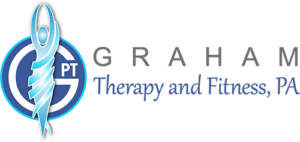
Shoulder pain can take many forms – it can show up when you’re reaching toward the top shelf to put dishes away or when you’re struggling to find a comfortable position to sleep in without feeling a sharp pain. It can show up as a result of an injury, making you feel as if your shoulder is immobile. There are numerous reasons why someone may experience shoulder pain. And the severity can range from the temporary discomfort of a pulled muscle to the agonizing bone-on-bone friction of arthritis. Whatever the case may be, Graham Therapy and Fitness is dedicated to offering you natural pain management modalities. Call our Bethesda physical therapy practice today to speak with a physical therapist. And find out how our services can benefit you!
Why do I have shoulder pain?
Your shoulder is capable of accomplishing many physical feats. However, with its complexities also comes the possibilities of pain and discomfort. It is a “ball-and-socket” joint, meaning the head of the upper arm bone, or “humerus,” fits perfectly in the corresponding space within the shoulder blade, or “scapula.” The ends of the bone are protected by a thick layer of cartilage, protecting the bones from rubbing together. Fluid-filled sacs called “bursae” also protect the tendons from rubbing against the bones. Tendons attach the bones in the shoulder to a set of bones, known as the rotator cuff. If something goes wrong with the intricacies that make up the mechanical interplay of the shoulder, pain can result.
The type of pain you feel in your shoulder can vary, depending on what is causing it. Pain from tendon impingement, for example, typically occurs as you raise your arm up, but stops before the arm is raised completely skyward. Pain resulting from a degenerated shoulder may create persistent aches every time you move your arm in certain directions. Acute injuries can result in sudden and intense pains that make it impossible for you to move your shoulder at all.
What is causing my shoulder pain?
The complexities of the shoulder joint present many opportunities for pain-causing conditions. According to WebMD, some of the most common causes of shoulder pain include:
- Dislocation. A shoulder dislocation can happen when the head of the humerus pops out of place. People who have sustained dislocation injuries report it as being enormously painful. And something that you become more vulnerable to after the first incidence.
- Tendinitis. Tendinitis occurs when the shoulder joint is excessively overused typically due to the demands of a laborious job or sport. This causes the tendons to undergo ongoing inflammation, resulting in swelling and painful impingement when raising your arm.
- Frozen shoulder. Also known as “adhesive capsulitis,” frozen shoulder can occur if your arm has been in a case or sling for a while, or if you have been bedridden for an extended period of time. When you don’t have opportunities to exercise the shoulder, the tissues can stiffen up on you, causing the painful condition known as frozen shoulder.
- Arthritis. The two main forms of arthritis that affect the shoulder are osteoarthritis and rheumatoid arthritis. Osteoarthritis occurs when the cartilage in the shoulder joint experiences significant “wear and tear,” typically due to age or excessive overuse. Rheumatoid arthritis occurs when the immune system decides to attack the membranes surrounding the shoulder joint, resulting in pain and inflammation.
Find relief through physical therapy:
Physical therapy is a natural, easy, and comfortable way to find relief for shoulder pain, without the need for harmful drugs or invasive surgery. Our Bethesda physical therapists have treated a number of conditions resulting in shoulder pain, with patients finding improvement and relief after just a few short sessions – and sometimes less!
Our physical therapists are movement experts, trained to pinpoint the cause of your pain through a variety of diagnostic techniques. Range of motion tests are used to discover which of your soft tissues are contributing to your pain, while X-rays can illustrate if you have sustained a dislocation or if you’re developing arthritis.
Once we have established the cause of your shoulder pain. Our physical therapist can create a specialized combination of physical therapy methods to manage and relieve your pain. These may include exercises, which have proven to ease the pain of osteoarthritis and reduce the stiffness of frozen shoulder. They may also include more specialized techniques, such as ice and heat therapies, ergonomics, or athletic training. Strengthening programs may also be implemented as a way to rehabilitate injured muscles or help stabilize a shoulder that is prone to dislocation.
Don’t let your shoulder pain limit your physical abilities any longer! Our Bethesda physical therapy practice will get you the help you need to start living your normal life once again. Contact Graham Therapy and Fitness in Bethesda, MD to schedule your appointment and get started on your path toward pain-relief.
FAQs
What is the most common shoulder injury?
Sprains and strains are among the most commonly experienced overuse injuries in the shoulder area. A strain occurs when a muscle or tendon is stretched too far or torn. A sprain occurs when a ligament is stretched too far or torn. Strains and sprains can result in an ongoing shoulder pain that may make it difficult to partake in exercise or even daily tasks. If the strain or sprain is minor, it can sometimes be iced at home and healed with rest. More severe strains and sprains will often require physical therapy treatments. Additional shoulder injuries include a torn cartilage, dislocation, tendinitis, frozen shoulder, and arthritis.
How do you know if my shoulder injury is serious?
Your shoulders can accomplish several physical feats due to their structure – however, this also means that they are susceptible to an increased risk of injury because of their complexity. If something becomes damaged in the make-up of the shoulders, pain and discomfort can develop. This pain may range from a dull ache to shooting pains, depending on the severity of the condition. If you are experiencing severe pain, or pain lasting three months or longer, it could be indicative of a deeper issue.
How do I get my shoulder to stop hurting?
If your shoulder is causing you discomfort, physical therapy is the best way to ensure the highest rate of relief. Our physical therapists are highly trained to help improve the flexibility and range of motion in your shoulder, in addition to relieving your pain and discomfort. This will be done through an individualized treatment plan designed specifically for you, and may include any combination of treatment methods as your physical therapist deems fit, including manual therapy, ice and heat therapies, electrical nerve stimulation, or ultrasound. Your physical therapist will also prescribe targeted exercises and stretches to help regain your optimal shoulder function.
How can physical therapy help with shoulder pain?
Two of the biggest goals of physical therapy are 1) to alleviate your pain and 2) to improve your function. Your physical therapist will work with you to make sure that both of these are achieved throughout your physical therapy sessions. Physical therapy has been proven to manage the pain of several conditions, and in many cases, it has even been proven to eliminate shoulder pain altogether, thus making the need for harmful drugs or surgical intervention obsolete.
Your Next Steps…
Request An Appointment
Receive A Custom Treatment Plan
Work Hard and Progress In Your Recovery
Recover & Enjoy Life Pain-Free!

